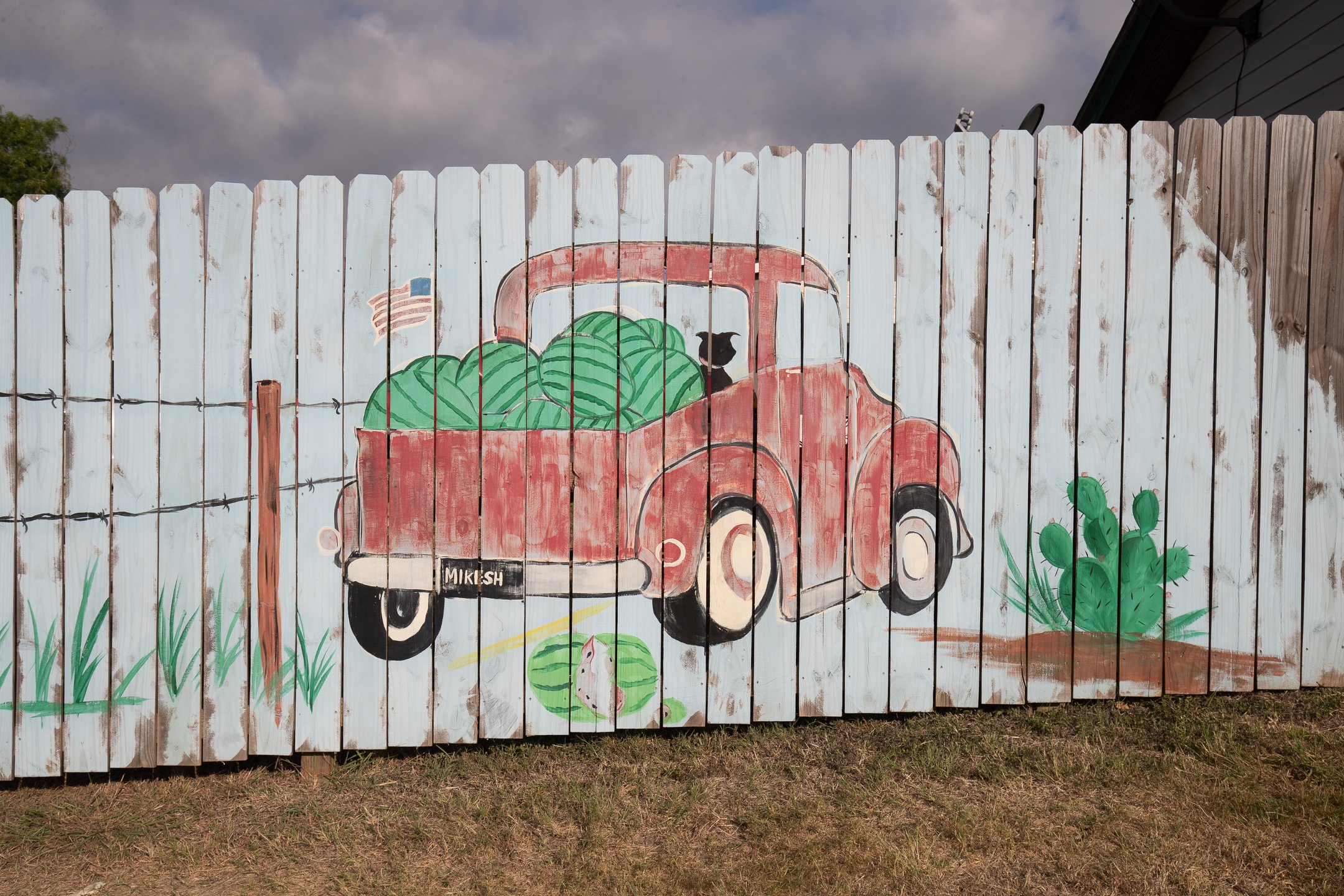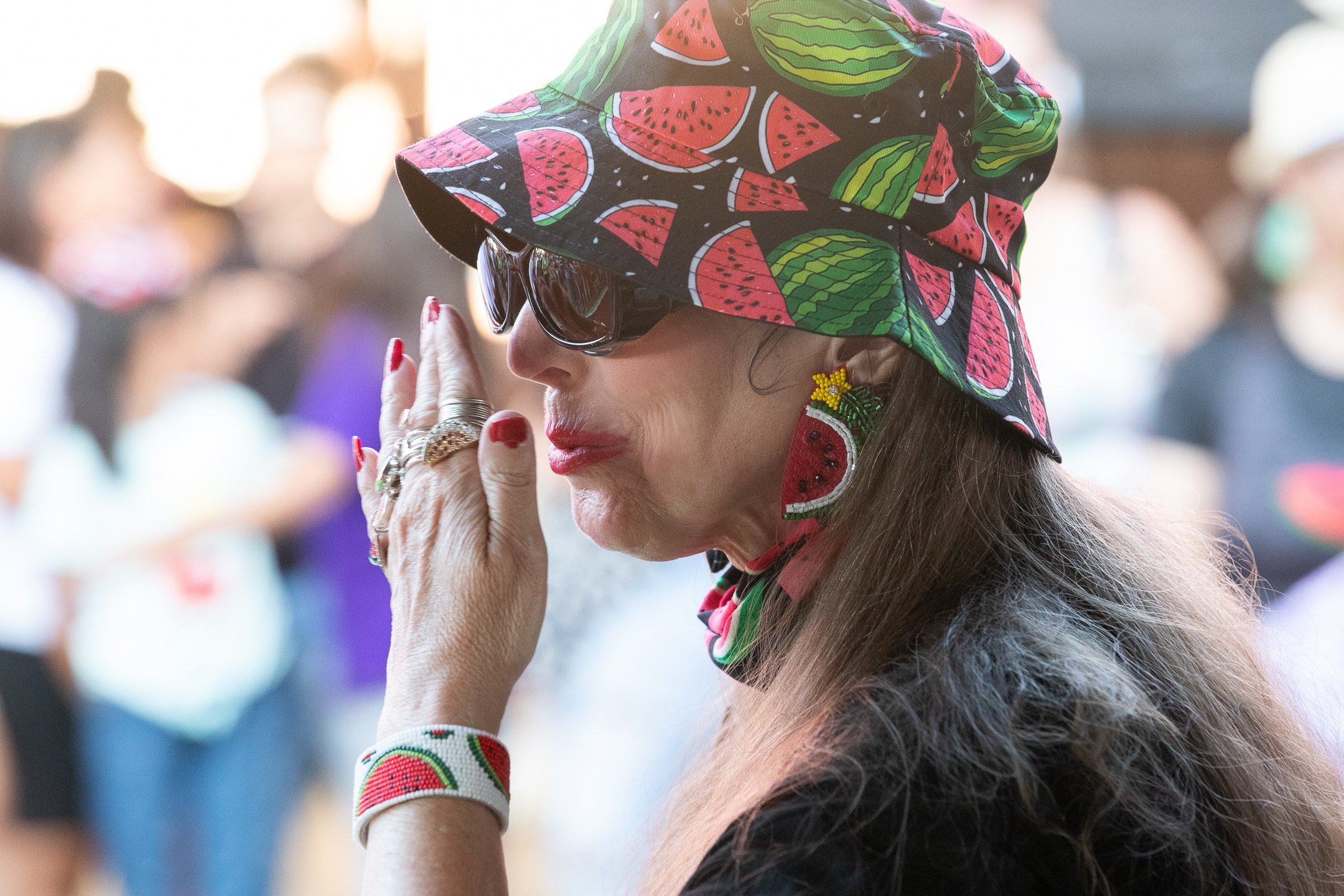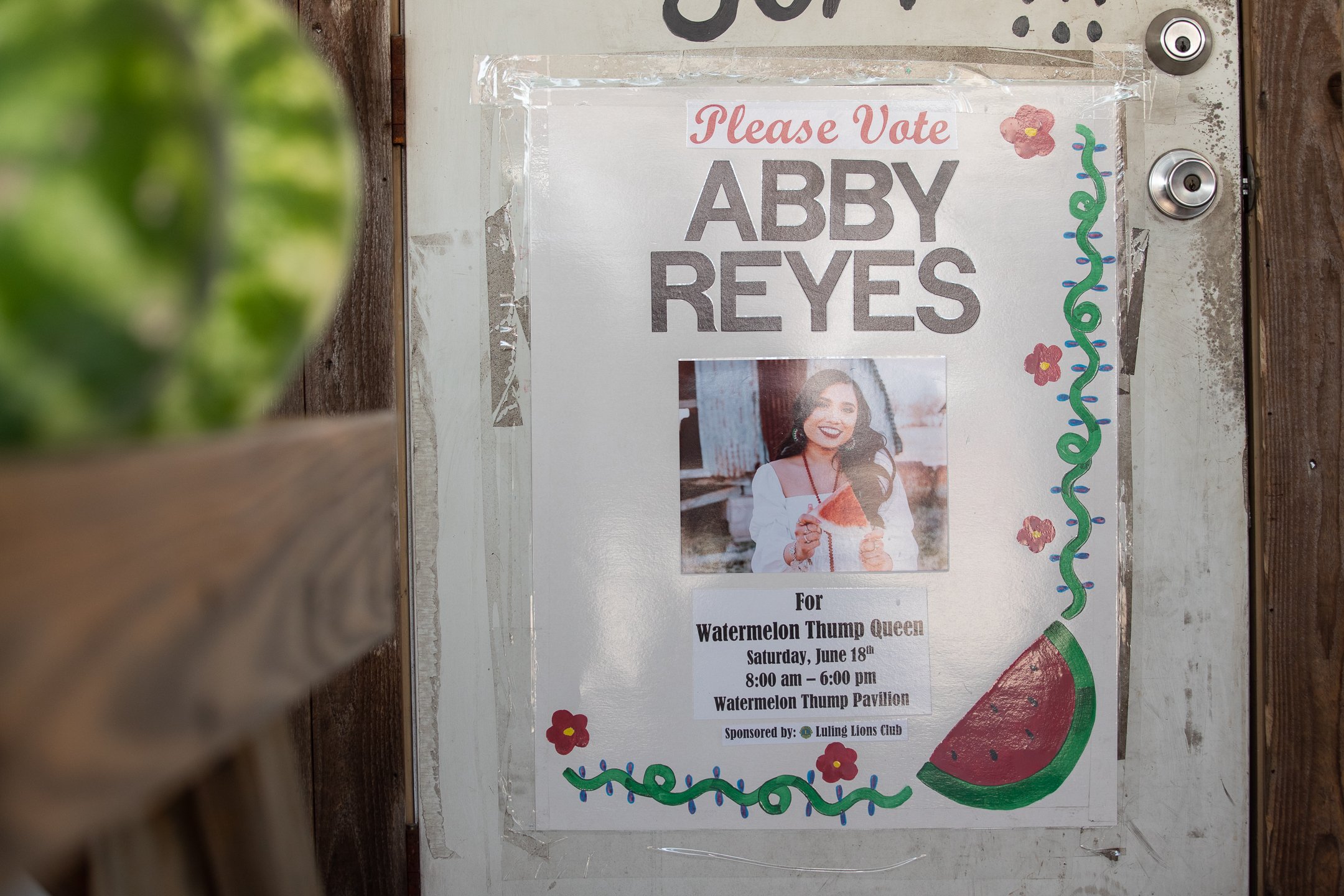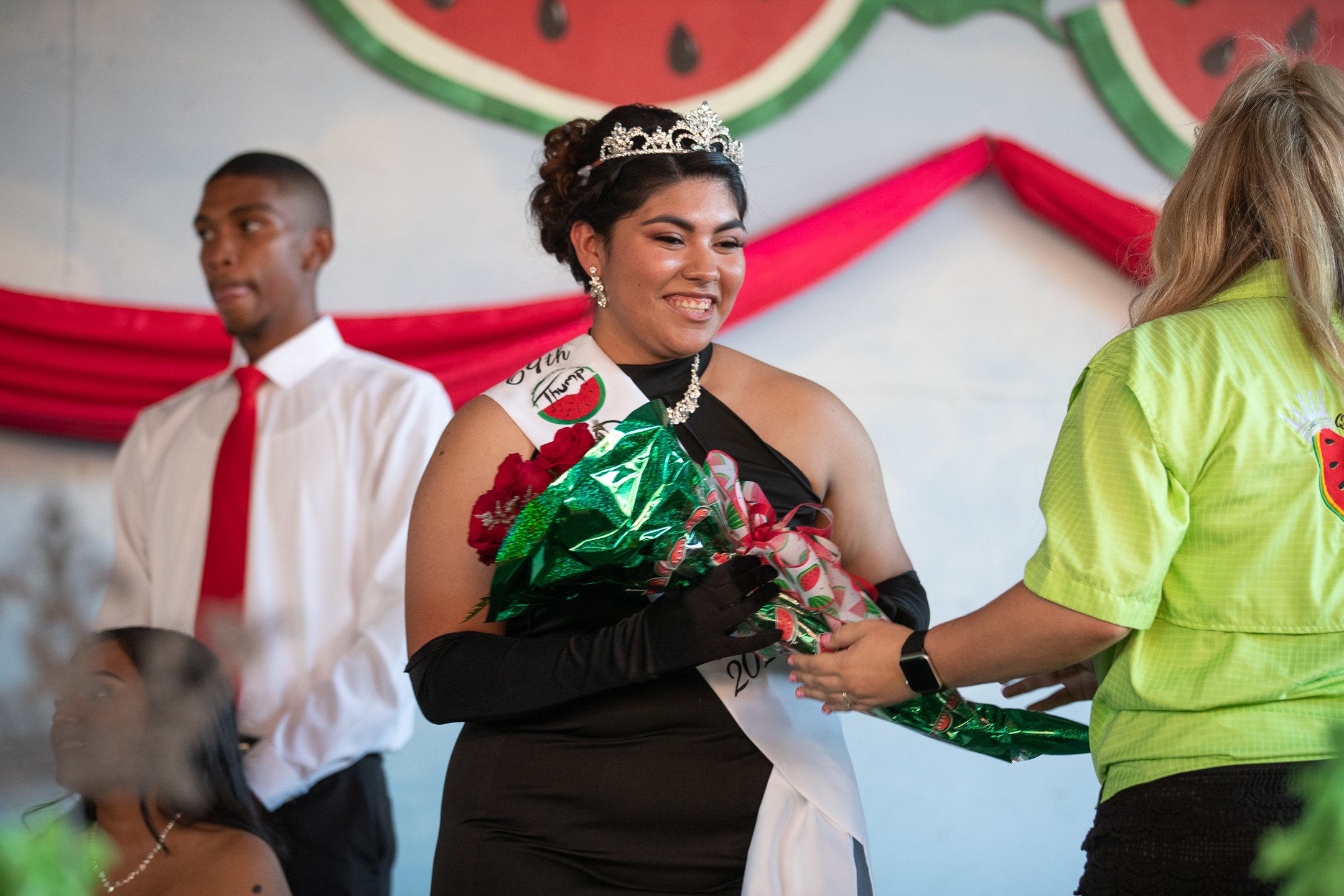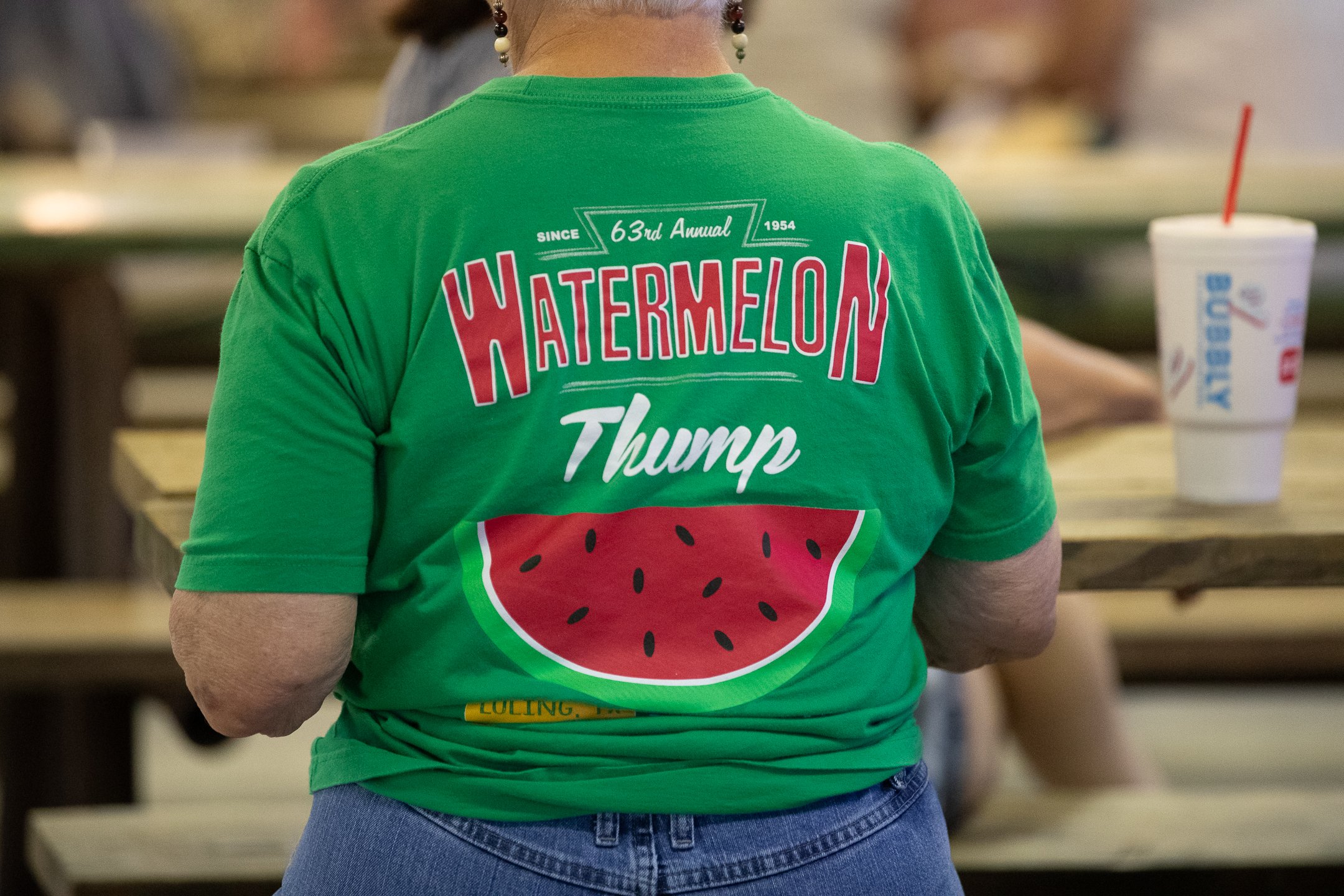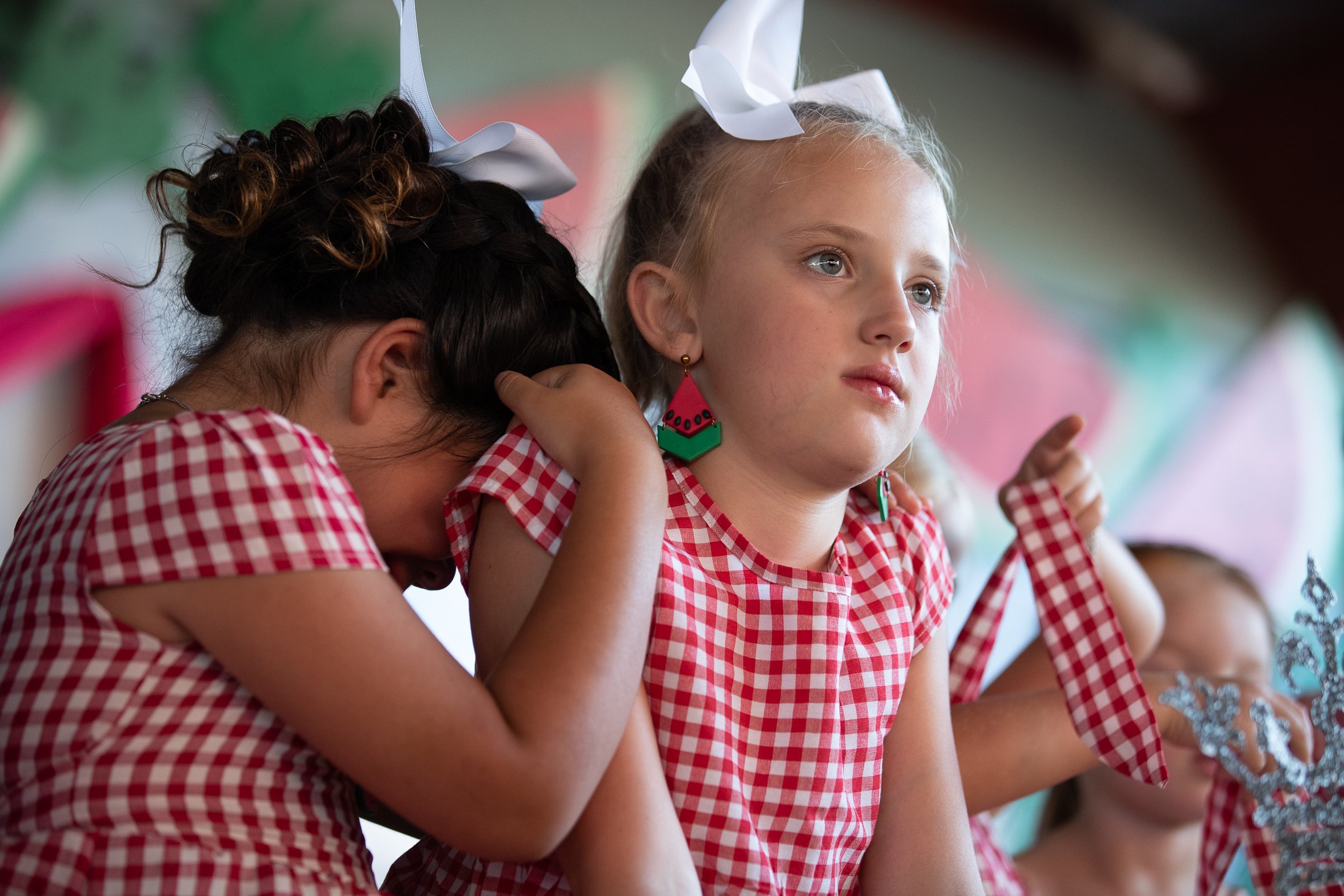Words by Shane Mitchell
Photos by Michael Cirlos
August 23, 2023
Michael Johnson Jr. deployed his secret weapon in a concrete alley splashed with watermelon murals. Before stepping up to the launch line at the Spitway, the 33-year-old welder plucked a seed from one of the Black Diamonds in the staging area and took a quick swig of water from a plastic bottle.
As the adult competition commenced, fans crowded bleachers on the sideline. Some contestants favored a running start, others arched their backs and planted their feet in a hero pose. A lucky breeze helps. Skipping or bouncing seeds count. But it really takes a lot of saliva to win the World Championship Seed Spitting Contest.
The Central Texas town of Luling, population 5,599, sits off a spur of the old Chisholm Trail and winds along the San Marcos River. A wildcatter struck oil in 1922, and many backyards are still dotted with pump jacks, like a plague of giant rusting grasshoppers. Barbecue is big around here, but so are watermelons. Or they used to be. (The town’s water tower is shaped like one.) Back in 1954, an elementary school principal first boosted a festival that is now known as the Luling Watermelon Thump, and this quiet little burg pulls in a fruit-loving crowd.
Months before the last weekend in June, campaign signs start to appear, slapped on the rear windows of pickups, tacked up in beauty parlors and dance halls, sprouted on front lawns and farm stalls, all respectfully requesting votes for the young women vying to become the next watermelon queen. Closer to the Thump, carnival rides rise on the main street, and farmers harvest their biggest melons and haul them to town in cardboard bins mounted on flatbed trailers, a cargo more precious than a barrel of crude.
The day kicked off with a parade. A cheerleading squad waggling green and white pom-poms, Shriners on funny tricycles, honking fire trucks and tooting marching bands, the newly crowned watermelon queen in a tulle ball gown, satin debutante gloves, and cowboy boots. Texans take float competitions seriously. So much glitter and shiny vinyl fringe. The Gonzales Chamber of Commerce featured a cannon and a “Come and Take It” flag. Mermaids flapped their fins on the Mermaid Capital of Texas Fest rig. A crew wearing Hispanic and African-themed costumes waved atop the Floresville Peanut Festival “ancestral remembrance” float. The Hood’s Texas Brigade flatbed was draped in Confederate battle flag banners.
Since 1954, every last full weekend of June, the Watermelon Thump has attracted fruit lovers to the oil and ranching town of Luling, Texas. Festivalgoers can participate in watermelon-eating and seed-spitting contests, watch the Thump Queen coronation, and cheer a competition of themed parade floats.
By noon, the weather app on my phone hit 104 degrees, not accounting for the heat index. Even under the shade of the town pavilion, the giant portacool fans couldn’t keep up. That didn’t stop the watermelon-eating contest or charity auction. (A 102.8-pound Black Diamond grand champion grown by local farmer Joey Mikesh sold for $3,000.) High school seniors peddled watermelon blender drinks. Visitors wore watermelon T-shirts, earrings, foam visors, dresses, nail appliques, and face paint. The goofier, the better. My favorite? A clever play on the Rolling Stones’ Hot Lips logo: a lolling red tongue studded with black seeds. And yet, in the farmers market at the other end of town, local fruit was a point of painful pride. The heyday of semis loaded with melons rolling down Interstate 10 was done and dusted. Labor costs, climate change, persistent soil diseases have taken their toll. A decade ago, the county had 22 growers, now only six hang on. Everyone else was a hobbyist.
“This year I cut back to five acres,” said Shane Watts. “Fertilizer prices did us in.” A fourth-generation farmer, he unloaded newly harvested Sangrias from his pickup for display in his family’s produce stall. He likes to grow small seedless varieties for families on a budget, because two for $10 stretches. “My wife’s favorite is the Gold Stripe. It’s the best orange meat there ever was, but a lot of the seed companies have been sold to foreigners, and they’re hard to find. So with the drought this year, I just planted enough to take care of my wife and save the seed.”
“How do you know when a melon is ripe?” I asked.
Watts patted one of his Jubilees. It sounded hollow.
“Tap on this one here,” he said. “Feel the vibration in your hands? Hear that deeper sound? That’s what the ‘thump’ is. You can really hear it in your seeded melons.”
Apparently, as a watermelon ripens, its natural frequency drops, hence the sound like a thump. A duller thud means the inside may have gone to mush. To be honest, this remains an inexact science, just like the shriveled vine and yellowing wear patch test. Some days, you just get lucky. Other days, you make margaritas.
Joey Mikesh (left, with JJ Rodriguez) is one of the last farmers in Central Texas to grow commercial watermelons. Mikesh competes every year to be the champion grower of Black Diamonds at the Luling Watermelon Thump.
Late in the afternoon, the spitting got underway.
“Don’t worry if you swallow a seed,” said the announcer, as challengers prepared in the alley entrance. “A watermelon won’t grow in your belly.”
I spent the pandemic dreaming about this contest. Spitting seeds was anathema as the world walked around in masks, and unsurprisingly, the festival in Luling paused. To sit on the sidelines and cheer grown people performing an act of utter silliness lightened the chaos that had clenched at my heart.
Rules are simple. All contestants get two spits. They must remain on the half watermelon launch pad. Their seeds need to fall inside the Spitway boundaries, and the final distance is calculated where each finally stops, rather than first lands. There are those who spit low and hard to achieve bounce; others position the pointy end facing outward between their teeth.
“I take a sip of water to help the seed stay slick,” Johnson told me. “It also helps to roll your tongue into a U shape and place the seed inside.”
Like a projectile in a slingshot.
“Solid spit,” said the announcer, as Thump Queen Abby Reyes kicked off the championship.
A.C. Garza won first place at the 2022 World Championship Seed Spitting Contest with a distance of 68 feet.
The best spitters hone their skills early. Youngest contestants were under 10. Speaking from personal experience, having chased my siblings around our childhood backyard with a mouthful of ammo, I know how much finesse it takes to land a seed on the sweaty back or sticky diaper of a brother or a sister. The contest draws rivals from Louisiana, Missouri, and Alabama, but hometown Luling usually has the advantage. When not in competition, Johnson builds offset smokers for Texas pitmasters. His wife, Paige, served as watermelon queen in 2010. Johnson told me his son would start competing in 2024.
He placed second, but won the team competition. His personal best is 53 feet, 4 inches.
The winner spit 68 feet. The Guinness world record for farthest distance to spit a watermelon seed is 75 feet, 2 inches, set by Jason Schayot of De Leon, Texas, in 1995.
Every year I wait for my own local melon season to arrive, and this one feels like it’s taken so much longer to get here.
But when it does, guess what I’m going to do?
Spit seeds. Spread joy.
Shane Mitchell has received five James Beard Foundation awards for her stories about food and culture. “The Wounded Fruit” is the ninth installment in her Crop Cycle series for The Bitter Southerner. She can’t paint a lick, but words will do just as well.
Michael Cirlos is a professional photographer and videographer in San Antonio specializing in content marketing, visual storytelling, and events. Michael’s work has appeared in several news media organizations, and he currently produces digital marketing content for brands like Red Bull, Verizon Wireless, the City of San Antonio, the National Park Service, and others. He enjoys craft beers and seeks to explore the world as much as possible.
The Wounded Fruit
Watermelon, that most thirst-quenching of fruits, has long nourished the imaginations of American artists. For the ninth installment of her Crop Cycle series, Shane Mitchell traces the visual evolution of its status as the bravura of still life to its weaponization as a racial trope to the triumph of diverse artists who are reclaiming it from infamy.



